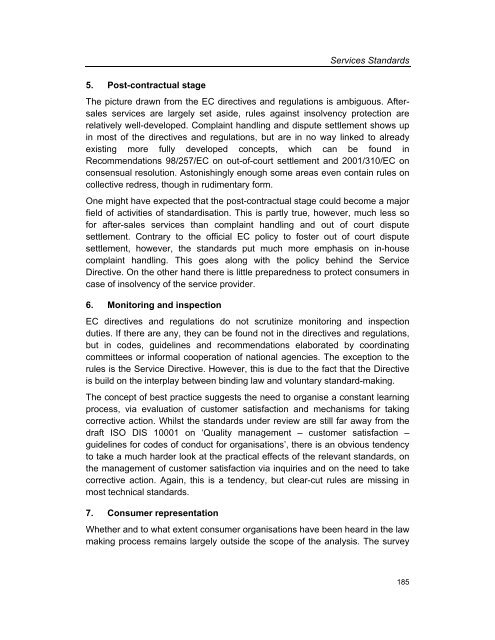Services Standards: Defining the Core Consumer Elements ... - ANEC
Services Standards: Defining the Core Consumer Elements ... - ANEC
Services Standards: Defining the Core Consumer Elements ... - ANEC
Create successful ePaper yourself
Turn your PDF publications into a flip-book with our unique Google optimized e-Paper software.
5. Post-contractual stage<br />
<strong>Services</strong> <strong>Standards</strong><br />
The picture drawn from <strong>the</strong> EC directives and regulations is ambiguous. Aftersales<br />
services are largely set aside, rules against insolvency protection are<br />
relatively well-developed. Complaint handling and dispute settlement shows up<br />
in most of <strong>the</strong> directives and regulations, but are in no way linked to already<br />
existing more fully developed concepts, which can be found in<br />
Recommendations 98/257/EC on out-of-court settlement and 2001/310/EC on<br />
consensual resolution. Astonishingly enough some areas even contain rules on<br />
collective redress, though in rudimentary form.<br />
One might have expected that <strong>the</strong> post-contractual stage could become a major<br />
field of activities of standardisation. This is partly true, however, much less so<br />
for after-sales services than complaint handling and out of court dispute<br />
settlement. Contrary to <strong>the</strong> official EC policy to foster out of court dispute<br />
settlement, however, <strong>the</strong> standards put much more emphasis on in-house<br />
complaint handling. This goes along with <strong>the</strong> policy behind <strong>the</strong> Service<br />
Directive. On <strong>the</strong> o<strong>the</strong>r hand <strong>the</strong>re is little preparedness to protect consumers in<br />
case of insolvency of <strong>the</strong> service provider.<br />
6. Monitoring and inspection<br />
EC directives and regulations do not scrutinize monitoring and inspection<br />
duties. If <strong>the</strong>re are any, <strong>the</strong>y can be found not in <strong>the</strong> directives and regulations,<br />
but in codes, guidelines and recommendations elaborated by coordinating<br />
committees or informal cooperation of national agencies. The exception to <strong>the</strong><br />
rules is <strong>the</strong> Service Directive. However, this is due to <strong>the</strong> fact that <strong>the</strong> Directive<br />
is build on <strong>the</strong> interplay between binding law and voluntary standard-making.<br />
The concept of best practice suggests <strong>the</strong> need to organise a constant learning<br />
process, via evaluation of customer satisfaction and mechanisms for taking<br />
corrective action. Whilst <strong>the</strong> standards under review are still far away from <strong>the</strong><br />
draft ISO DIS 10001 on ‘Quality management – customer satisfaction –<br />
guidelines for codes of conduct for organisations’, <strong>the</strong>re is an obvious tendency<br />
to take a much harder look at <strong>the</strong> practical effects of <strong>the</strong> relevant standards, on<br />
<strong>the</strong> management of customer satisfaction via inquiries and on <strong>the</strong> need to take<br />
corrective action. Again, this is a tendency, but clear-cut rules are missing in<br />
most technical standards.<br />
7. <strong>Consumer</strong> representation<br />
Whe<strong>the</strong>r and to what extent consumer organisations have been heard in <strong>the</strong> law<br />
making process remains largely outside <strong>the</strong> scope of <strong>the</strong> analysis. The survey<br />
185
















